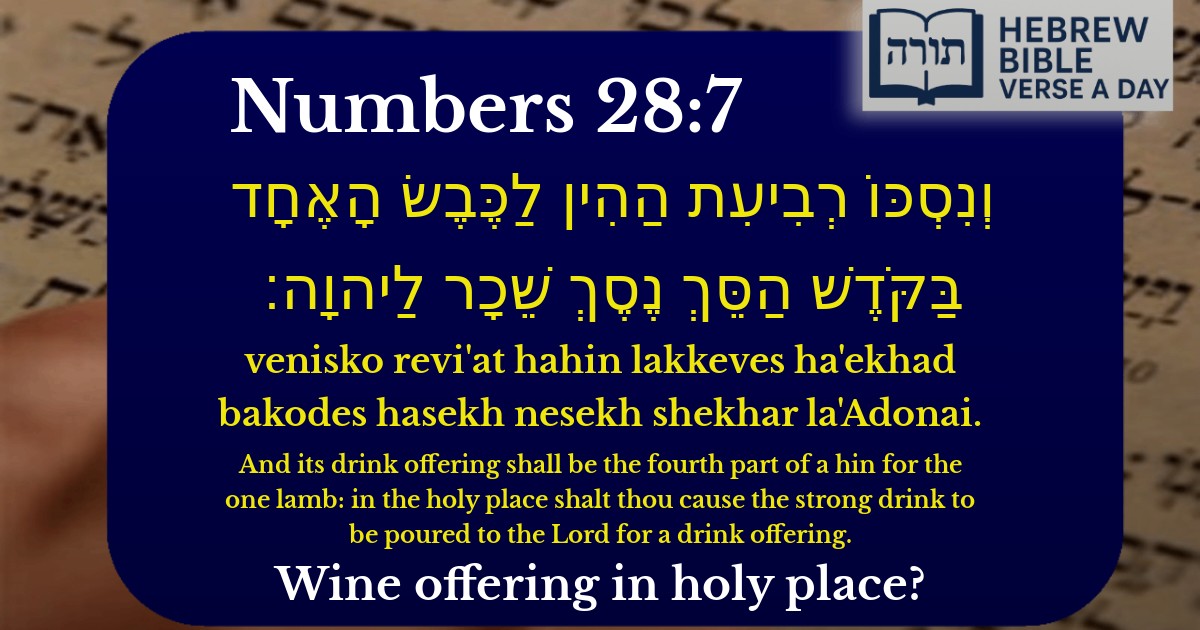Frequently Asked Questions
Q: What is the meaning of the drink offering mentioned in Numbers 28:7?
A: The drink offering (נֶסֶךְ) in Numbers 28:7 refers to a liquid offering of wine that was poured on the altar alongside certain sacrifices in the Temple. According to Rashi, this was part of the daily Tamid (continual) offering, where a quarter of a hin (a biblical measurement) of wine was poured for each lamb sacrificed. The Talmud (Menachot 104b) explains that this act symbolizes devotion to Hashem, as the wine represents joy and gratitude.
Q: Why was wine used as a drink offering in the Temple?
A: Wine was chosen for the drink offering because it represents joy and elevation in Jewish tradition (see Talmud, Berachot 35a). Rambam (Hilchot Maaseh HaKorbanot 2:3) explains that wine, as a significant and valuable beverage, was fitting to be offered to Hashem as a sign of dedication. The pouring of wine on the altar also accompanied the flour and oil offerings, creating a complete expression of gratitude.
Q: How much is a 'quarter of a hin' of wine in modern measurements?
A: A hin is a biblical liquid measurement, and a quarter of a hin equals approximately 1.5 liters (or about 3 pints) according to traditional Jewish sources (see Rashi on Exodus 29:40). This amount was required for each lamb offered in the daily Tamid sacrifice. The Talmud (Eruvin 83a) discusses measurements in halacha, emphasizing precision in Temple service.
Q: What can we learn from the concept of a drink offering today?
A: Although we no longer bring physical drink offerings without the Temple, the lesson remains that we should dedicate our joys and blessings to Hashem. The Midrash (Vayikra Rabbah 27:11) teaches that just as wine gladdens the heart, our service to Hashem should be done with happiness. Today, this can be expressed through prayer, Torah study, and acts of kindness with a joyful heart.
Q: Why was the drink offering poured specifically in the 'holy place'?
A: The verse specifies that the drink offering was poured in the 'holy place' (בַּקֹּדֶשׁ) to emphasize that it was part of the sacred Temple service. Rashi explains that this refers to the altar in the courtyard of the Mishkan (Tabernacle) or later the Temple. The Talmud (Zevachim 88a) teaches that every detail of the sacrificial service had to be performed in its proper place to maintain the sanctity of the offering.


Explanation of the Verse
The verse (Numbers 28:7) discusses the nesech (drink offering) that accompanies the daily tamid (continual) sacrifice in the Beit HaMikdash (Holy Temple). The amount specified is a quarter of a hin of wine for each lamb offered. This teaches the importance of consistency and precision in divine service, as the measurements are fixed by Torah law.
Rashi's Commentary
Rashi (Rabbi Shlomo Yitzchaki) explains that the phrase "בַּקֹּדֶשׁ הַסֵּךְ" ("in the holy place shalt thou cause to be poured") refers to the wine being poured specifically at the base of the altar, as derived from the Sifrei (a halachic Midrash). This emphasizes that even the act of pouring must be done with sanctity and in the designated area.
Rambam's Perspective
In Hilchos Temidin u'Musafin (1:4), the Rambam (Maimonides) codifies this law, stating that the drink offering is an inseparable part of the korban (sacrifice). He further clarifies that the wine must be poured only during the day, as all sacrificial rites must be performed in daylight (based on Leviticus 6:2).
Symbolism of the Measurement
The quarter-hin measurement is significant:
Halachic Details from the Talmud
The Talmud (Menachos 89a) discusses the precise method of pouring: